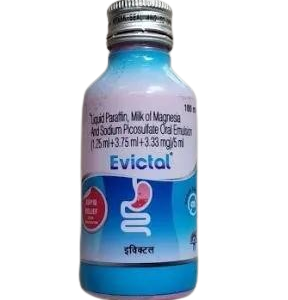LIQUID PARAFFIN + MILK OF MAGNESIA + SODIUM PICOSULPHATE
Liquid Paraffin: Liquid Paraffin, also known as white oil or mineral oil, is a medicinal product commonly used as a laxative. It belongs to a group of drugs called emollients or lubricants.
The main use of liquid paraffin is to relieve constipation by softening the stool and making it easier to pass. It works by coating the lining of the intestine, which helps to retain water and keep the stool soft. It also lubricates the stool, reducing friction and facilitating its movement through the digestive system.
Liquid paraffin is available as an oral solution and is usually taken by mouth. The recommended dose may vary depending on the individual and the severity of the constipation. It is typically administered in a dose of 15-30 mL (1-2 tablespoons) at bedtime, followed by an increase or decrease in dose based on the response. It is important to follow the instructions provided by the healthcare provider or the package insert.
While liquid paraffin is generally considered safe when used as directed, it can cause some side effects, especially if taken in excessive amounts. Common side effects may include:
1. Gastrointestinal discomfort: This may include stomach cramps, bloating, abdominal pain, and diarrhea.
2. Decreased absorption of fat-soluble vitamins: Long-term use or excessive intake of liquid paraffin may interfere with the absorption of important fat-soluble vitamins (A, D, E, and K), leading to potential deficiencies.
3. Lipid pneumonia: If liquid paraffin is accidentally inhaled, it can enter the lungs and cause lipid pneumonia. This is more likely to occur in individuals with swallowing difficulties or in children.
4. Mineral oil aspiration: Swallowing large amounts of liquid paraffin may result in aspiration, which can cause a serious lung condition known as lipoid pneumonia.
It is important to note that liquid paraffin should be used for short-term relief of constipation and not relied upon for extended periods without medical guidance. If constipation persists or worsens, it is advisable to consult a healthcare professional for further evaluation and specific treatment recommendations.
Milk Of Magnesia: Milk of Magnesia, also known by its generic name magnesium hydroxide, is an over-the-counter medication primarily used to relieve constipation and irregular bowel movements.
The mechanism of action of Milk of Magnesia involves drawing water into the intestines, which softens the stool and stimulates bowel movements. This effect is due to the osmotic properties of magnesium hydroxide. It also has antacid properties and can be used to relieve symptoms of acid reflux, heartburn, and indigestion.
The recommended dose of Milk of Magnesia for constipation relief is 2 to 4 tablespoons (30-60 mL) taken orally, followed by a full glass of water. For acid reflux and heartburn relief, a usual dose is 1-2 tablespoons (15-30 mL) taken orally up to 4 times a day, or as directed by a healthcare professional. It is important to read the instructions and follow the recommended dosage guidelines provided by the manufacturer or healthcare provider.
Like any medication, Milk of Magnesia may cause side effects. Common side effects may include diarrhea, stomach cramps, and dehydration. These side effects are usually mild and temporary. However, if these symptoms persist or worsen, it is important to consult a healthcare professional. It is also recommended to drink plenty of water while taking Milk of Magnesia to prevent dehydration.
Individuals who have kidney problems or are on a low-magnesium diet should use Milk of Magnesia with caution. Additionally, it is important to consult a healthcare professional before using Milk of Magnesia if you are pregnant, breastfeeding, or have any underlying medical conditions.
Overall, Milk of Magnesia is a commonly used medication for the short-term relief of constipation and symptoms of acid reflux. It should be used as directed and if any concerns or side effects arise, it is important to seek medical advice.
Sodium Picosulphate: Sodium Picosulphate is a laxative medication used to treat constipation. It belongs to the class of drugs known as stimulant laxatives.
The primary mechanism of action of Sodium Picosulphate is the stimulation of the intestines, specifically the colon, to increase the muscular contractions (peristalsis). It acts on the nerve plexus in the intestinal wall, promoting the movement of stool through the colon and facilitating bowel movements.
The recommended dose of Sodium Picosulphate varies depending on the age and condition of the patient. In general, for adults and children over 10 years old, the usual dose is 5-10 mg once daily, preferably taken at bedtime. For children aged 4-10 years, the usual dose is 5 mg once daily, and for children under 4 years old, the dose is 2.5 mg once daily.
Common side effects of Sodium Picosulphate include diarrhea, abdominal cramps, nausea, and electrolyte imbalances if used for an extended period. These side effects are generally mild and temporary. However, it is important to note that prolonged or excessive use of Sodium Picosulphate can lead to electrolyte disturbances, dehydration, and dependence on laxatives.
It is crucial to follow the prescribed dosage and duration of treatment recommended by your healthcare provider. If you experience severe or persistent side effects or have concerns about the medication, it is advised to consult a healthcare professional for further guidance.


